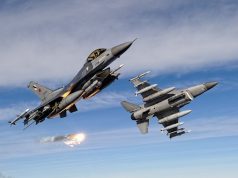A US Navy Ticonderoga-class guided-missile cruiser and an Arleigh Burke-class guided-missile destroyer have entered the Black Sea for exercises with NATO allies and partners in the region.
Cruiser USS Monterey (CG 61) and destroyer USS Thomas Hudner (DDG 116), both part of the USS Dwight D. Eisenhower carrier strike group (IKE CSG), entered the Black Sea on March 20.
Shortly after transiting the Bosphorus Strait, Monterey conducted multi-domain air and surface warfare integration operations with F/A-18 Super Hornets from the Dwight D. Eisenhower CSG Carrier Air Wing (CVW) 3, Turkish and US Air Forces Europe and Africa KC-135s, a US Navy P-8A maritime patrol aircraft, and NATO aircraft.
“Monterey’s presence in the Black Sea reinforces our continued commitment to operate with our NATO allies,” said Capt. Joseph A. Baggett, Commanding Officer, USS Monterey (CG 61). “Together, we enhance security and stability in the region through cooperation, understanding and collaboration. These efforts and our cooperative relationships are key in safeguarding the region’s vital links to the global economy.”
The main reason the ships entered the Black Sea is to participate in the Romania-led exercise Sea Shield.
It is worth noting that NATO Standing Maritime Group Two (SNMG2), composed of Spanish frigate ESPS Cristobal Colon, Bulgarian frigate BGS Smeli, Romanian frigate ROS Regina Maria and Turkey’s TCG Kemalreis (Turkey), is also operating in the Black Sea. The group will also be joining the Romanian exercise.
“This is a great opportunity for our ship to operate with our NATO allies and partners in the Black Sea region,” said Cmdr. Bo Mancuso, commanding officer, USS Thomas Hudner (DDG 116). “We are committed to security and stability in the region and are excited to enhance our combined readiness and naval capabilities.”
USS Monterey and USS Thomas Hudner are deployed as part of the USS Dwight D. Eisenhower CSG, which also includes destroyers USS Mitscher, USS Laboon, and USS Mahan.
The aircraft carrier has remained in the Mediterranean Sea, as the Montreux Convention limits the total tonnage of warships a country with no Black Sea shores can have in the region to 15,000 tons.
The Montreaux Convention from 1936 also regulates the movement of submarines through the strait, and forbids non-Black Sea nations to deploy submarines to the region. What is more, even submarines of countries with Black Sea shores may only pass through the strait for repairs. Russian submarines, however, are said to frequently join operations or drills in the Med before heading for repairs.
This week, Improved Kilo-class submarine Krasnodar (B-265) exited the Black Sea and the only convention-compliant reason would be necessary repairs. It remains to be seen whether it will be joining a Russian task group currently operating in the Mediterranean. Earlier this week, another Black Sea Fleet submarine returning from repairs in St. Petersburg, the Rostov-on-Don, caused a scare after reportedly managing to evade NATO radar following its transit of the Strait of Gibraltar.
It is also worth noting that reports from last week say that all Russian submarines in the Black Sea were underway in response to the upcoming NATO exercises. Considering the fact that Krasnodar exited the region, and that the Rostov-on-Don was presumably still in the Mediterranean, this means that up to four Black Sea Fleet Improved Kilos are prowling the Black Sea.



























